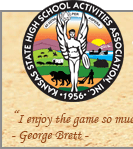 |
 |
 |
 |
 |
 |
 |
Off-Season Information
Baseball Off-Season Regulations
We get many questions about players and coaches participating in fall league baseball teams. Below are some important guidelines:
- Coaches employed by the school to coach baseball CANNOT coach teams with their potential players during the school year outside the season of sport. This includes head, assistant, and Rule 10 coach’s aides for grades 9-12.
- School employed coaches (head, assistant, Rule 10) may not give lessons/private instruction to potential players at their school during the school year outside the season of sport.
- No more than five (5) members of the school squad the previous season can play or practice on a non-school team during the school year outside the season of sport.
- School Year is defined as the Tuesday after Labor Day until the Saturday before Memorial Day.
- School squad is defined as A-team, B-team, 9th grade, C-team, JV, Varsity, etc. – these are all different squads.
- Any amount of time played (an inning, pinch running, pinch hitting, courtesy runner) constitutes team membership.
- If a player played on two levels the previous season (JV & V) they would count as one of the five (5)possible JV players and one of the five (5) Varsity players.
- Players may not be rotated in from week to week or game to game. The roster established for the non-school team may have no more than five (5) from the same school squad.
- School transportation cannot be used to take students to fall league games.
- A school coach could transport the players to the fall league but not in school vehicles and cannot coach them.
- School year is defined as the Tuesday after Labor Day until the Saturday before Memorial Day.
- If the Middle School/Junior High does not have a baseball program the 9th graders would not be limited to five (5) because they have not been on a school team the previous year.
- Once the school season starts (first day of practice) players may not play or practice on a non-school team until their membership on the school team is over.
- While a member of the school team a player may not participate on an outside team in that same sport. They may participate in other activities, but should inform the school coach.
- In the spring, after a player is no longer a part of the school team, players are restricted to no more than five (5) players playing or practicing on the same non-school team until the Saturday before Memorial Day.
Rationale for Limiting Participation
The rationale member schools have given for limiting participation on non-school teams during the school year prior to the season of sport is detailed below.
- Schools want to avoid perpetuation of a single sport on a year around basis. This avoids pressure on students to forgo other school activities or sports in the name of specializing in a single sport.
- Overly demanding or aggressive coaches could dominate student athletes’ time in the off season and summer months by demanding they play on certain teams or by controlling who plays with whom on non-school rosters. This would erode the fundamental purpose of schools offering a variety of activities to students, namely variety of participation and formulating different relationships with other coaches and sponsors as well as different groups of students. Schools do believe students shouldn’t feel pressured or obligated to give up an interest in another sport or activity, to pursue sport specialization.
- There is a legitimate concern for economically disadvantaged students who aren’t able to afford participation in club sports and traveling select teams. Students know very well their ability to make the cut for school teams is often determined by their non-school participation. Schools feel an obligation to protect the interests of all students insofar as possible.
- Socially, schools want to encourage youngsters to meet and interact with young people from other schools. Friendships and experiences are enriched when young people broaden themselves beyond their immediate school. Kids benefit from meeting and playing with students from other schools and communities.
- Transfer students and physical “late bloomers” are accommodated by a rule limiting outside team membership. This reduces the likelihood of entire school teams remaining intact during the off season thereby reducing the opportunity for transferring students and players of less experience and ability to develop in hopes of making the school team next season.
- Seeks to protect student-athletes from over use injuries which are becoming epidemic as young athletes who specialize in one sport play year round.


